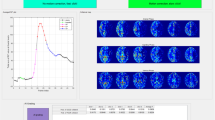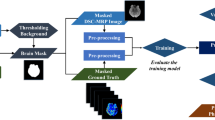Abstract
Purpose
Collateral evaluation is typically done using visual inspection of cerebral images and thus suffers from intra- and inter-rater variability. Large open databases of ischemic stroke patients are rare, limiting the use of deep learning methods in treatment decision-making.
Methods
We adapted a pre-trained EfficientNet B0 network through transfer learning to improve collateral evaluation using slice-based and subject-level classification. Our method uses stacking and overlapping of 2D slices from a patient’s 4D computed tomography angiography (CTA) and a majority voting scheme to determine a patient’s final collateral grade based on all classified 2D MIPs. Class imbalance is handled in the evaluation process by using the focal loss with class weight to penalize the majority class.
Results
We evaluated our method using a nine-fold cross-validation performed with 83 subjects. Mean sensitivity of 0.71, specificity of 0.84, and a weighted F1 score of 0.71 in multi-class (good, intermediate, and poor) classification were obtained. Considering treatment effect, a dichotomized decision is also made for collateral scoring of a subject based on two classes (good/intermediate and poor) which achieves a sensitivity of 0.89 and specificity of 0.96 with a weighted F1 score of 0.95.
Conclusion
An automatic and robust collateral assessment method that mitigates the issues with the small imbalanced dataset was developed. Computer-aided evaluation of collaterals can help decision-making of ischemic stroke treatment strategy in clinical settings.


Similar content being viewed by others
References
Xiao Y, Alamer A, Fonov V, Lo BW, Tampieri D, Collins DL, Rivaz H, Kersten-Oertel M (2017) Towards automatic collateral circulation score evaluation in ischemic stroke using image decompositions and support vector machines, pp 158–167
Zhang S, Chen W, Tang H, Han Q, Yan S, Zhang X, Chen Q, Parsons M, Wang S, Lou M (2016) The prognostic value of a four-dimensional ct angiography-based collateral grading scale for reperfusion therapy in acute ischemic stroke patients. PLoS One 11(8)
Grotta JC, Chiu D, Lu M, Patel S, Levine SR, Tilley BC, Brott TG, Haley EC Jr, Lyden PD (1999) Kothari, other: Agreement and variability in the interpretation of early CT changes in stroke patients qualifying for intravenous rtPA therapy. Stroke 30(8):1528–1533
Grunwald IQ, Kulikovski J, Reith W, Gerry S, Namias R, Politi M, Papanagiotou P, Essig M, Mathur S, Joly O (2019) other: Collateral automation for triage in stroke: Evaluating automated scoring of collaterals in acute stroke on computed tomography scans. Cerebrovasc Dis 47(5–6):217–222
Mumu A, Tampieri D, Rivaz H, Kersten-Oertel M, Xiao Y (2020) Automatic collateral circulation scoring in ischemic stroke using 4d CT angiography with low-rank and sparse matrix decomposition. Int J Comput Assist Radiol Surg 15(9):1501–1511
Do L-N, Park I, Yang H-J, Baek B-H, Nam Y, Yoon W (2018) Automatic assessment of dwi-aspects for assessment of acute ischemic stroke using 3d convolutional neural network. In: Proceedings of the The 6th international conference on big data applications and services, Zhengzhou, China, pp 19–22
Do L-N, Baek BH, Kim SK, Yang H-J, Park I, Yoon W (2020) Automatic assessment of aspects using diffusion-weighted imaging in acute ischemic stroke using recurrent residual convolutional neural network. Diagnostics 10(10):803
Su J, Wolff L, van Es ACM, van Zwam W, Majoie C, Dippel DW, van der Lugt A, Niessen WJ, Van Walsum T (2020) Automatic collateral scoring from 3d CTA images. IEEE Trans Med Imaging 39(6):2190–2200
Jung S-M, Whangbo T-K (2020) A deep learning system for diagnosing ischemic stroke by applying adaptive transfer learning. J Int Technol 21(7):1957–1968
Tetteh G, Navarro F, Paetzold J, Kirschke J, Zimmer C, Menze BH (2021) A deep learning approach to predicting collateral flow in stroke patients using radiomic features from perfusion images. arXiv preprint arXiv:2110.12508
Neethi A, Niyas S, Kannath SK, Mathew J, Anzar AM, Rajan J (2022) Stroke classification from computed tomography scans using 3d convolutional neural network. Biomed Signal Process Control 76:103720
Kim Y-C, Chung J-W, Bang OY, Hong M, Seo W-K, Kim G-M, Yeop Kim E, Lee JS, Hong JM, Liebeskind DS, Saver JL (2022) A deep learning-based automatic collateral assessment in patients with acute ischemic stroke. Trans Stroke Res, 1–7
Pexman JW, Barber PA, Hill MD, Sevick RJ, Demchuk AM, Hudon ME, Hu WY, Buchan AM (2001) Use of the Alberta stroke program early CT score (ASPECTS) for assessing CT scans in patients with acute stroke. Am J Neuroradiol 22(8):1534–1542
Yosinski J, Clune J, Bengio Y, Lipson H (2014) How transferable are features in deep neural networks? Adv Neural Inf Process Syst, 27
Swati ZNK, Zhao Q, Kabir M, Ali F, Ali Z, Ahmed S, Lu J (2019) Brain tumor classification for MR images using transfer learning and fine-tuning. Comput Med Imaging Graph 75:34–46
Tan M, Le Q (2019) Efficientnet: Rethinking model scaling for convolutional neural networks. In: International conference on machine learning, pp 6105–6114. PMLR
Fonov V, Evans AC, Botteron K, Almli CR, McKinstry RC, Collins DL, Group BDC (2011) Unbiased average age-appropriate atlases for pediatric studies. Neuroimage 54(1):313–327
Avants BB, Epstein CL, Grossman M, Gee JC (2008) Symmetric diffeomorphic image registration with cross-correlation: evaluating automated labeling of elderly and neurodegenerative brain. Med Image Anal 12(1):26–41
Russakovsky O, Deng J, Su H, Krause J, Satheesh S, Ma S, Huang Z, Karpathy A, Khosla A, Bernstein M, Berg AC, Fei-Fei L (2015) Imagenet large scale visual recognition challenge. Int J Comput Vis 115(3):211–252
Sandler M, Howard A, Zhu M, Zhmoginov A, Chen L-C (2018) Mobilenetv2: Inverted residuals and linear bottlenecks. In: Proceedings of the IEEE conference on computer vision and pattern recognition, pp 4510–4520
Ali K, Shaikh ZA, Khan AA, Laghari AA (2021) Multiclass skin cancer classification using efficientnets–a first step towards preventing skin cancer. Neurosci Inform, 100034
Lin T-Y, Goyal P, Girshick R, He K, Dollár P (2017) Focal loss for dense object detection. In: Proceedings of the IEEE international conference on computer vision, pp 2980–2988
Tan I, Demchuk A, Hopyan J, Zhang L, Gladstone D, Wong K, Martin M, Symons S, Fox A, Aviv R (2009) Ct angiography clot burden score and collateral score: correlation with clinical and radiologic outcomes in acute middle cerebral artery infarct. Am J Neuroradiol 30(3):525–531
Sarraf S, DeSouza DD, Anderson J, Tofighi G (2017) Deepad: Alzheimer’s disease classification via deep convolutional neural networks using mri and fmri. BioRxiv, 070441
Tajbakhsh N, Shin JY, Gurudu SR, Hurst RT, Kendall CB, Gotway MB, Liang J (2016) Convolutional neural networks for medical image analysis: Full training or fine tuning? IEEE Trans Med Imaging 35(5):1299–1312
Mehra R (2018) Breast cancer histology images classification: Training from scratch or transfer learning? ICT Express 4(4):247–254
Kaur T, Gandhi TK (2019) Automated brain image classification based on vgg-16 and transfer learning. In: 2019 international conference on information technology (ICIT), pp 94–98. IEEE
Osama S, Zafar K, Sadiq MU (2020) Predicting clinical outcome in acute ischemic stroke using parallel multi-parametric feature embedded Siamese network. Diagnostics 10(11):858
Liu C-F, Padhy S, Ramachandran S, Wang VX, Efimov A, Bernal A, Shi L, Vaillant M, Ratnanather JT, Faria AV, Caffo B, Albert M, Miller MI (2019) Using deep Siamese neural networks for detection of brain asymmetries associated with Alzheimer’s disease and mild cognitive impairment. Magn Reson Imag 64:190–199
Acknowledgements
We acknowledge the support of the Natural Sciences and Engineering Research Council of Canada (NSERC) for granting this study. We would like to thank Dr. Ali Alamer and Dr. Johanna Ortiz Jimenez for facilitating data acquisition and annotation.
Author information
Authors and Affiliations
Corresponding author
Ethics declarations
Conflict of interest
The authors declare that they have no conflict of interest.
Informed Consent
Informed consent was obtained from all participants included in the study.
Ethical approval
All procedures performed in studies involving human participants were in accordance with the ethical standards of the University Human Research Ethics Committee.
Additional information
Publisher's Note
Springer Nature remains neutral with regard to jurisdictional claims in published maps and institutional affiliations.
Supplementary Information
Below is the link to the electronic supplementary material.
Rights and permissions
Springer Nature or its licensor (e.g. a society or other partner) holds exclusive rights to this article under a publishing agreement with the author(s) or other rightsholder(s); author self-archiving of the accepted manuscript version of this article is solely governed by the terms of such publishing agreement and applicable law.
About this article
Cite this article
Aktar, M., Reyes, J., Tampieri, D. et al. Deep learning for collateral evaluation in ischemic stroke with imbalanced data. Int J CARS 18, 733–740 (2023). https://doi.org/10.1007/s11548-022-02826-6
Received:
Accepted:
Published:
Issue Date:
DOI: https://doi.org/10.1007/s11548-022-02826-6




